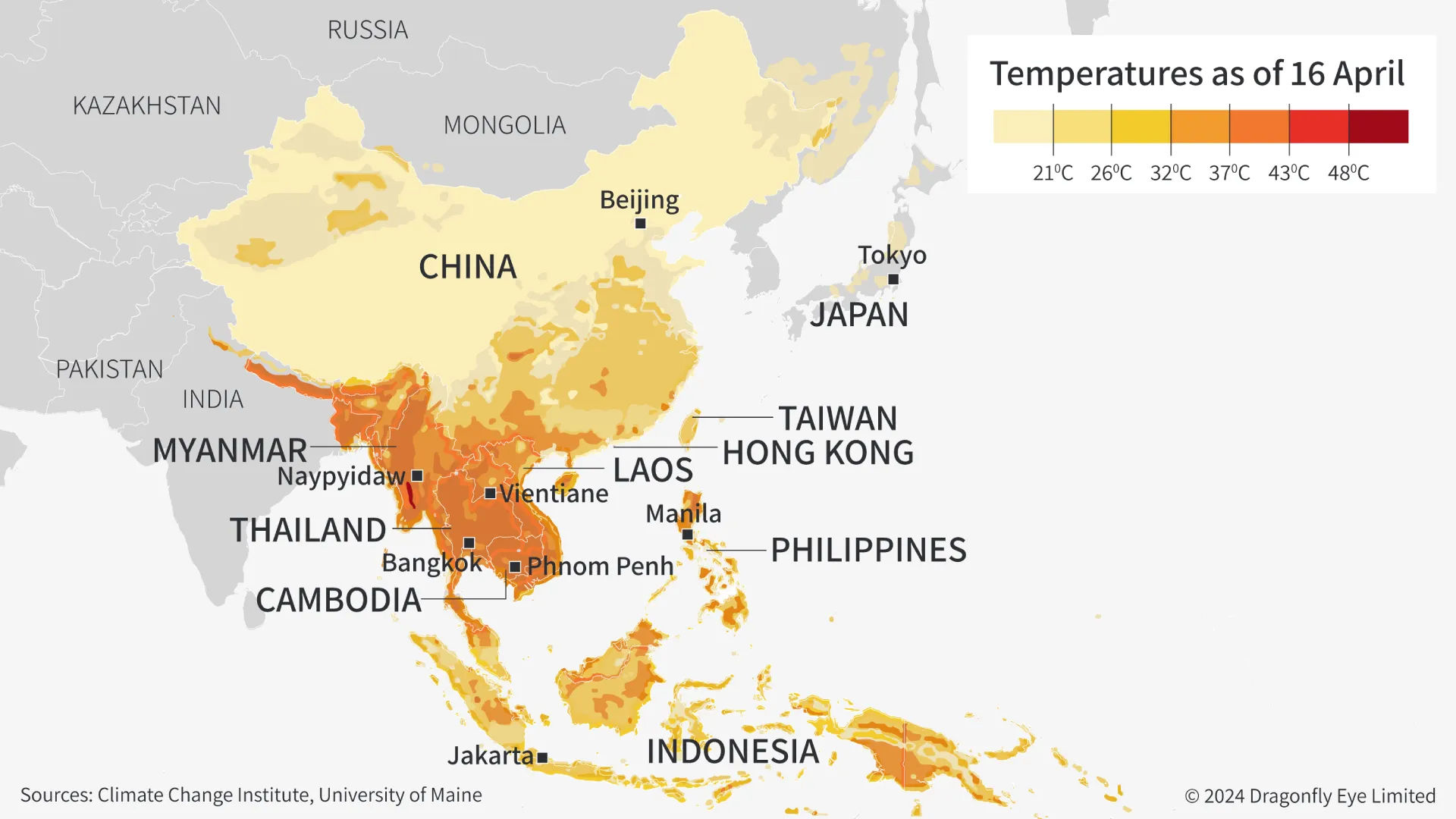Record-high temperatures in several countries in Southeast Asia are likely to disrupt local business operations and heighten medical risks in the coming few months.
This assessment was issued to clients of Dragonfly’s Security Intelligence & Analysis Service (SIAS) on 17 April 2024.
- Several local governments have issued health warnings in the past month and implemented restrictions, including on water use
- We assess that operations in the Philippines, Vietnam, Myanmar and Thailand are likely to be most affected
High temperatures in countries in Southeast Asia are likely to lead to operational disruption for firms and heightened medical risks in the coming months. Intense heat over the past few weeks has led to governments issuing health warnings in the Philippines, Malaysia, Thailand and Vietnam. Official forecasts suggest such temperatures will persist until May at least. This will probably result in staff absenteeism, water and electricity shortages and restrictions on normal working practices, such as the implementation of mandatory breaks.
Elevated temperatures across the region
Higher-than-usual temperatures have been recorded in countries across Southeast Asia in recent weeks. In the Philippines, the official heat index reached ‘dangerous’ levels earlier this month and is in place for several areas as of 15 April, including for the National Capital Region. There have also been record temperatures in Thailand and Vietnam, with the authorities in provinces in southern Vietnam declaring a state of emergency in early April. The local authorities have attributed these abnormally high temperatures to the El Nino weather phenomenon and forecast them to last until May.
Exacerbation of health risks and disruption to operations
High temperatures are likely to sustain elevated health risks in the region for the coming months. The local governments have all issued heat warnings in the past month, most of which are still in place. This includes alerts for 14 areas in Malaysia (such as Kelantan, Sarawak and Sabah) and Thailand during the Songkran festival until 17 April. According to the WHO, heat waves can result in various illnesses such as hyperthermia and lead to hospitalisation or even death.

There are also likely to be heightened health risks associated with poor air quality in Southeast Asia during this period. High temperatures are conducive to wildfires in the region, worsening already-poor air quality in countries such as Cambodia, Myanmar, Thailand and Vietnam. This often results in respiratory issues, particularly for people with chronic illnesses and those working outdoors. Still, this is unlikely to result in a major strain on local hospital systems, based on recent years.
Heatwaves will also probably lead to operational disruptions, particularly for firms in the manufacturing and construction sectors. This is due to staff absenteeism from heat-related illnesses and restrictions on working hours imposed by the government. The Philippine authorities said last week that employees are allowed not to report to work amid heatwaves and advised firms to schedule breaks from the heat. And based on local press reporting, heatwaves seem to primarily affect heat-exposed labour-intensive industries such as construction.
Water and electricity shortages likely
There are likely to be some water shortages in parts of Southeast Asia as a result of heat waves in the coming months. This is particularly in southern parts of Vietnam where the authorities last week warned of a potential shortage of drinking water and an impact on agriculture due to a lack of water for irrigation. Similarly, the Philippines authorities in early April warned of possible water rationing measures in Metro Manila and urged residents to practise conservation measures amid El Nino and the dry season that usually lasts until May.
Unscheduled temporary blackouts and power rationing measures are also probable in countries such as China, the Philippines and Vietnam. This was the case last year when the use of air conditioning led to high electricity demand. For instance, in Vietnam manufacturing firms temporarily suspended operations due to unplanned outages in industrial zones near Hanoi as well as Bac Ninh and Bac Giang province. And during a heat wave in August 2022, the authorities in China imposed restrictions on manufacturing in Anhui, Jiangsu and Zhejiang provinces
Image: Buddhist monks collect alms with their heads covered with a towel during a heatwave in Yangon, Myanmar, on 24 April 2023. Photo by Sai Aung Main/AFP via Getty Images.




